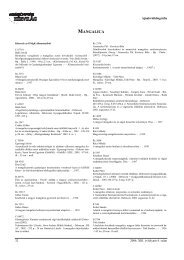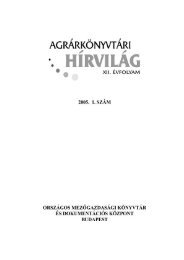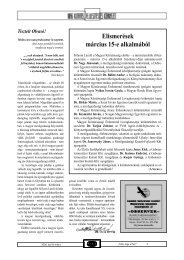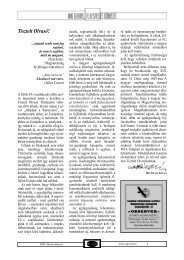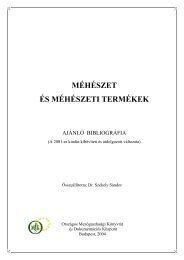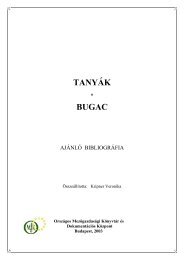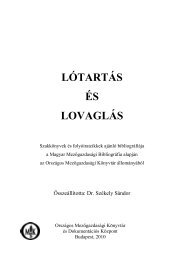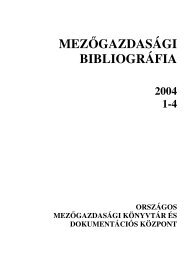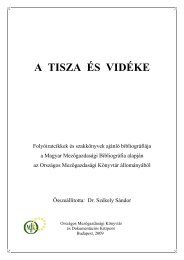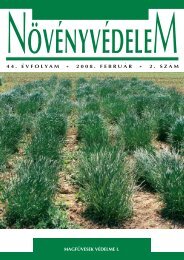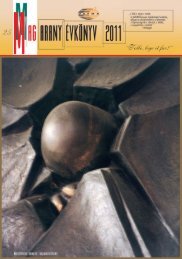hUNGARiAN AGRicUltURAl RESEARch
hUNGARiAN AGRicUltURAl RESEARch
hUNGARiAN AGRicUltURAl RESEARch
Create successful ePaper yourself
Turn your PDF publications into a flip-book with our unique Google optimized e-Paper software.
Particle size Xaverage (mm) .<br />
Effect of peripheral hammer speed on particle size of meal and on milling performance (using a<br />
5.5kW motor and a screen of 5mm mesh size)<br />
3.5<br />
7000<br />
3<br />
2.5<br />
2<br />
1.5<br />
1<br />
0.5<br />
Xaverage (mm)<br />
Pmech (W)<br />
Poly. (Pmech (W))<br />
Linear (Xaverage (mm))<br />
0<br />
0<br />
0 10 20 30 40 50 60 70 80 90 100<br />
Figure 4: With increase in peripheral hammer speed average particle<br />
size (x average) decreases and mechanical power (Pmech)<br />
requirement increases<br />
thirteenth second, as a result of the<br />
sudden opening of the bolt lock,<br />
real milling started and the<br />
mechanical torque measurable on<br />
the axis was increased and<br />
therefore also the mechanical<br />
power, as well as the electric<br />
power taken from the grid. After<br />
the fifteenth second, the first<br />
comminuted particles appeared at<br />
the output of the mill which were<br />
captured on a weighing scale.<br />
During the process of comminution,<br />
the particles in the work<br />
space warmed up from the initial<br />
11 °C to 14 °C.<br />
I used sieve analysis for the<br />
qualification of the meal produced<br />
and from the data obtained in this<br />
way I determined the average<br />
particle size belonging to the<br />
respective settings.<br />
The method described above<br />
was carried out with three<br />
repetitions per treatment according<br />
to the experimental plan using<br />
different peripheral hammer speeds.<br />
Experimental results show that<br />
by means of a continuously<br />
variable regulation of the number<br />
of revolutions, without any stop<br />
and change of screen plates, the<br />
same output particle size can be<br />
achieved as in the case of the<br />
Peripheral speed of hammer V per (m/s)<br />
6000<br />
5000<br />
4000<br />
3000<br />
2000<br />
1000<br />
Mechanical power Pmech (W) .<br />
traditional change of sieves.<br />
Figure 4 is an illustration of the<br />
effect of the increase in the<br />
number of revolutions of the<br />
hammer mill on particle size (×<br />
average) and on the mechanical<br />
power (P mech ) measured on the<br />
axis of the mill.<br />
The working number of<br />
revolutions (v per =80m/s) of the<br />
mill fitted with a 5.5kW motor was<br />
accompanied by an average<br />
particle size of 1.3 mm, while<br />
the slower hammer speed<br />
(v per =20m/s) was accompanied by<br />
a particle size of 2.5 mm. Within<br />
the range of these two numbers of<br />
revolutions, with a continuously<br />
variable regulation, a meal of any<br />
average particle size desired can<br />
be produced.<br />
Based on the results of the<br />
experiment, a linear relationship<br />
can be seen between the increase<br />
in the peripheral speed of the<br />
hammer and the increase in meal<br />
fineness. A greater number of<br />
revolutions also involves a greater<br />
impulse force in the case of the<br />
same geometry, thereby the<br />
comminution energy produced is<br />
also greater. [2]<br />
The continuously variable<br />
regulation of the number of<br />
revolutions is most easily carried<br />
out by using a frequency drive.<br />
A satisfactory growth of<br />
livestock requires as a minimum<br />
condition that feeds are available<br />
in the required quantity and<br />
quality. One of the parameters<br />
influencing quality is the average<br />
particle size of feed. The<br />
possibility to adjust particle size<br />
during comminution can open up<br />
new perspectives for the improvement<br />
of economic indicators of<br />
feed production. The continuously<br />
variable particle size output can be<br />
a new perspective field for the<br />
technological improvement of<br />
feed production.<br />
References<br />
[1] Fekete, L. (1995): Sertéstakarmányozás,<br />
Mezôgazda<br />
Kiadó, Bp. 146–149.p.<br />
[2] Fogarasi, L., Petrócki, K.,<br />
Judák, E., Korzenszky, P.<br />
(2008): (Comminution-kinetic<br />
and energetic foundation of<br />
automatic control of grinders),<br />
XXXII. Kutatási és fejlesztési<br />
tanácskozás az agrárgazdaság<br />
gépesítésérôl (2008. január)<br />
SZIE Gödöllô ISBN 963-611-<br />
438-2ö, ISBN 963-611-439-0<br />
[3] Korzenszky, P., Judák, E.<br />
(2005): Measurement Assembly<br />
for Energetic Analysis<br />
of Comminuters, Hungarian<br />
Agricultural Engineering,<br />
18/2005, (72–74. p) HU ISSN<br />
0864-7410<br />
[4] Korzenszky, P. (2007): Effect<br />
of Hammer Speed on Particle<br />
Size Distribution in Hammer<br />
Mills, Hungarian Agricultural<br />
Engineering 20/2007, 76. p.,<br />
(51–52. p.) HU ISSN 0864–7410<br />
[5] Schmidt, J. szerk. (1996): Takarmányozástan,<br />
Mezôgazda<br />
kiadó, Budapest, 288.p.<br />
[6] Wondra, B. (1995): Effect of<br />
particle size and pelleting on<br />
growth performance, nutrient<br />
digestibility, and stomach<br />
morphology in finishing pigs.<br />
J. Anim. Sci. 73: 757.<br />
16 Hungarian Agricultural Research 2009/3–4



